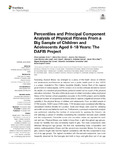Mostrar o rexistro simple do ítem
Percentiles and Principal Component Analysis of Physical Fitness From a Big Sample of Children and Adolescents Aged 6-18 Years: The DAFIS Project
| dc.contributor.author | Iglesias-Soler, Eliseo | |
| dc.contributor.author | Rúa-Alonso, María | |
| dc.contributor.author | Rial-Vázquez, Jessica | |
| dc.contributor.author | Lete-Lasa, José-Ramón | |
| dc.contributor.author | Clavel San Emeterio, Iván | |
| dc.contributor.author | Giráldez-García, Manuel Avelino | |
| dc.contributor.author | Rico-Díaz, Javier | |
| dc.contributor.author | Rodríguez-Del Corral, Miguel | |
| dc.contributor.author | Carballeira, Eduardo | |
| dc.contributor.author | Dopico-Calvo, Xurxo | |
| dc.date.accessioned | 2021-04-20T16:27:16Z | |
| dc.date.available | 2021-04-20T16:27:16Z | |
| dc.date.issued | 2021-02-19 | |
| dc.identifier.citation | Iglesias-Soler E, Rúa-Alonso M, Rial-Vázquez J, Lete-Lasa JR, Clavel I, Giráldez-García MA, Rico-Díaz J, Corral MR-D, Carballeira-Fernández E and Dopico-Calvo X (2021) Percentiles and Principal Component Analysis of Physical Fitness From a Big Sample of Children and Adolescents Aged 6-18 Years: The DAFIS Project. Front. Psychol. 12:627834. doi: 10.3389/fpsyg.2021.627834 | es_ES |
| dc.identifier.issn | 1664-1078 | |
| dc.identifier.uri | http://hdl.handle.net/2183/27784 | |
| dc.description.abstract | [Abstract] Assessing physical fitness has emerged as a proxy of the health status of children and adolescents and therefore as relevant from a public health point of view. DAFIS is a project included in Plan Galicia Saudable (Healthy Galicia Plan) of the regional government of Galicia (Spain). DAFIS consists of an on-line software devoted to record the results of a standard physical fitness protocol carried out as a part of the physical education curriculum. The aims of this study were: to obtain normative values of physical fitness of the Galician school population evaluated in the DAFIS project, and to identify a reduced number of components and tests able to capture a significant amount of the variability in the physical fitness of children and adolescents. From an initial sample of 27784 records, 15287 cases (7543 males, 7744 females) were considered after filtering. Generalized Additive Models for Location, Scale and Shape were used for obtaining percentile curves and tables for each sex. Furthermore, a principal components analysis was performed, selecting the number of components by applying the Kaiser’s rule and selecting a subset of variables considering the correlation between each variable and the components. Percentile curves and normative values are reported for each test and sex. Physical fitness was better in boys than in girls throughout age groups, except for flexibility that was consistently higher in girls. Two main components were detected throughout age groups: the first one representing body composition and partially cardiorespiratory fitness and the second one muscular fitness. For boys and girls, waist to height ratio had the highest correlations with the first component in four out of six age groups. The highest correlation with the second component, was most frequently observed for the handgrip test both in boys and girls (four out of six age groups). This study provides evidence about the utility of school community actions like DAFIS aimed to track the health-related fitness of children and adolescents. The results suggest that fat mass distribution (i.e., waist to height ratio and waist circumference) and muscular performance (mainly handgrip) concentrate a high proportion physical fitness variance. | es_ES |
| dc.language.iso | eng | es_ES |
| dc.publisher | Rubén Maneiro | es_ES |
| dc.relation.uri | https://doi.org/10.3389/fpsyg.2021.627834 | |
| dc.rights | Atribución 4.0 Internacional | es_ES |
| dc.rights.uri | http://creativecommons.org/licenses/by/4.0/ | * |
| dc.subject | Health-related fitness | es_ES |
| dc.subject | Adolescents | es_ES |
| dc.subject | Children | es_ES |
| dc.subject | Cardiorespiratory fitness | es_ES |
| dc.subject | Anthropometry | es_ES |
| dc.subject | Muscular fitness | es_ES |
| dc.subject | Motor fitness | es_ES |
| dc.subject | Percentiles | es_ES |
| dc.subject | Salud y forma física | es_ES |
| dc.subject | Adolescentes | es_ES |
| dc.subject | Niños | es_ES |
| dc.subject | Capacidad cardiorespiratoria | es_ES |
| dc.subject | Antropometría | es_ES |
| dc.subject | Tono muscular | es_ES |
| dc.subject | Habilidades motoras | es_ES |
| dc.subject | Saúde e forma física | es_ES |
| dc.subject | Nenos | es_ES |
| dc.subject | Capacidade cardiorespiratoria | es_ES |
| dc.title | Percentiles and Principal Component Analysis of Physical Fitness From a Big Sample of Children and Adolescents Aged 6-18 Years: The DAFIS Project | es_ES |
| dc.type | info:eu-repo/semantics/article | es_ES |
| dc.rights.access | info:eu-repo/semantics/openAccess | es_ES |
| UDC.journalTitle | Frontiers in Psychology | es_ES |
| UDC.volume | 12 | es_ES |
| dc.identifier.doi | 10.3389/fpsyg.2021.627834 |
Ficheiros no ítem
Este ítem aparece na(s) seguinte(s) colección(s)
-
GI-PHG - Artigos [70]
-
GI-GIGG - Artigos [111]






